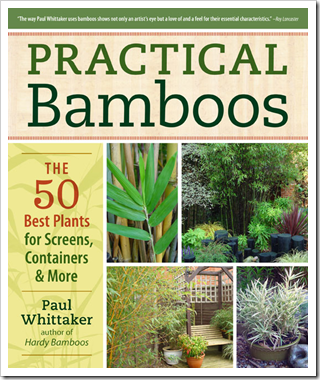Book review: “Practical Bamboos” by Paul Whittaker
Paul Whittaker has over 30 years of experience as a horticulturist, landscaper and nurseryman and is one of the UK’s leading bamboo experts. He and his wife run a renowned nursery in Norfolk, PW Plants, specializing in ornamental grasses, bamboos and hardy exotics.
His first bamboo book, Taming the Dragon: Hard Bamboos, was published five years ago to universal acclaim and was voted Reference Book of the Year 2005 by the Garden Writers' Guild.
Paul’s second bamboo book, Practical Bamboos: The 50 Best Plants for Screens, Containers & More, has just been published by Timber Press in softcover for a list price of $19.95 (available from Amazon and other online sellers at the usual discount).
This is a richly illustrated book that bills itself as a “practical guide” recommending the “best 50 beginner bamboos for a wide range of purposes, sites and conditions”. When I first read this blurb on the back cover, I was taken aback a bit by the phrasing “beginner bamboos”, expecting the text to be too simplistic to have much appeal—or use—for experienced bamboo growers or collectors.
I’m happy to say that my fears were completely unfounded. Yes, Paul covers a lot of information in the beginning chapters that bamboo aficionados are already familiar with, but it’s written in such a clear and concise style that I never thought, “gosh, I already know all this, this is so dull.” Quite the opposite. Since Paul’s writing is informed by his professional experience, the book is actually of particular interest to bamboo fans looking for practical growing advice.
The first 50 pages of this 175-page book cover general information, including climate and habitat, structure and growing habits, use in landscaping, and container culture. These chapters are particularly useful for gardeners just starting out with bamboo but also serve as a valuable refresher to experienced bamboo growers.
The “meat” of the book are profiles of 50 bamboos that Paul considers to have special merit. For each bamboo, there’s information on hardiness, dimensions, uses and combinations as well as a handy checklist that visually indicates whether a particular species is short, medium or tall, invasive, cold-hardy, heat tolerant, suited for containers, etc. No other bamboo book that I’m familiar with is organized in such a visually attractive format.
In fact, the overall structure and layout of the book is very thoughtful. It is obvious that a lot of consideration went into the design, with a particular emphasis on making this book as user-friendly as possible. The photographs (over 150 in a 175-page book!) are as excellent technically as they are beautiful and useful; in fact, this is the most lavishly illustrated bamboo book that I’ve ever seen.
The only point of criticism I could make is the use of non-standard common names for some bamboos. As I’ve mentioned in other posts, many bamboos don’t really have common names so botanical (Latin) names are typically used when talking or writing about bamboos. Some growers and sellers come up with their own common names in an attempt to make things easier for casual gardeners, but this often leads to confusion. Paul does address the issue of common vs. Latin names but then proceeds to introduce common names that I’ve never come across before, such as “giant foxtail bamboo” for Chusquea gigantea or “oily bamboo” for Fargesia angustissima (in the U.S. listed as Borinda angustissima). This is really only a bone of contention for serious collectors; for most people, it’s a non-issue.
To sum up my impressions of Practical Bamboos, I find it to be one of the best written, most beautifully illustrated and most useful book for people interested in adding bamboo to their garden. Even die-hard bamboo collectors who think they know it all will find something new and interesting to learn, and they will definitely enjoy the stunning photographs.
For more bamboo-related books that I find useful, please go to this page.



Do you already own this book? Sounds Great.
ReplyDeleteThis is a good book. I especially appreciate the landscaping ideas it provides using this very special plant. Paul does a great job explaining how this misunderstood plant can serve many functions in the average garden.
ReplyDeleteIf you had to choose just one of the two books, which would it be? I really like "Taming the dragon..." but I found the data on cold-hardiness and spreading habits to be inappropriate for my climate. At the same time, having a book that I can lend to a friend who is interested in learning about bamboo would be nice.
ReplyDeleteAlan, Taming the Dragon covers many more species than Practical Bamboos and as such is more geared towards people who are really into bamboo. Practical Bamboos is a great book for beginners; it contains the most important information without the more arcane stuff. And the photos are beautiful. I would imagine that data on cold-hardiness and spreading is the same in both books.
ReplyDelete